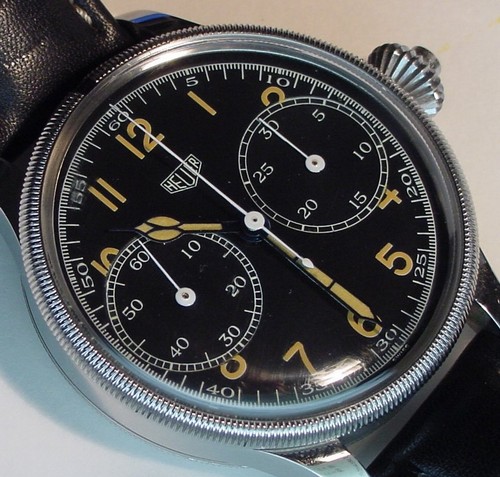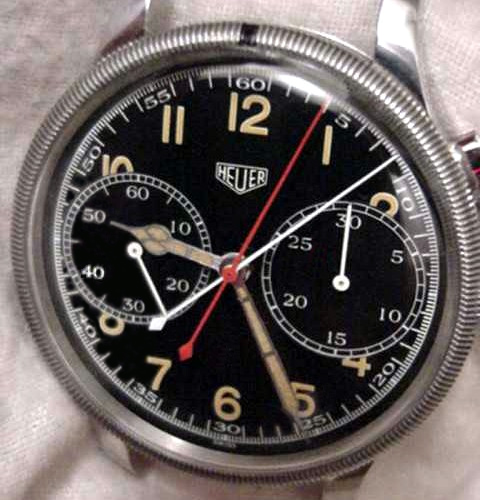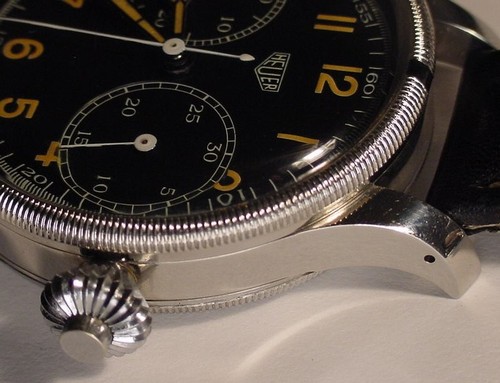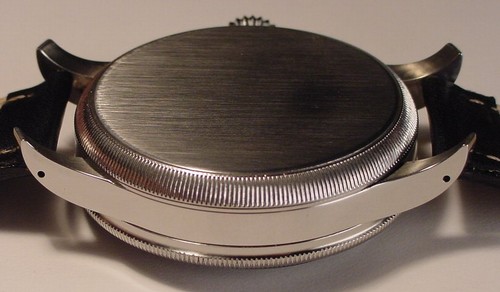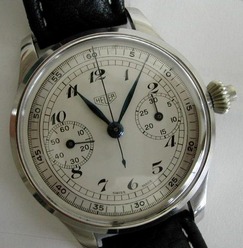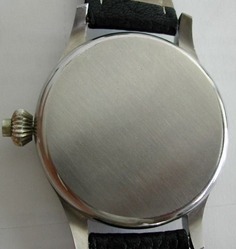|
Since October
2002, approximately 20 oversized chronographs
bearing the "Heuer" name have been offered or sold
through ebay or other websites. These chronographs
have been sold as vintage "Heuer" timepieces, with
prices in the range between $3000 and $4800. These
chronographs are typically described as "vintage"
or "new old stock" timepieces, and often described
as having some association with the "Targa Florio",
"Grand Prix" racing of the period or "Rallye"
events. Over the past
several months, there has been considerable
controversy about whether these chronographs are
genuine Heuer chronographs, made by Heuer in the
1950's, or "fakes", being produced currently in
Eastern Europe. In May 2003, we presented the key
arguments in this debate, which led us to conclude
that these chronographs are probably modern-day
reproductions, and not vintage Heuer timepieces. We
have recently had further conversations with
reliable sources which have led us to conclude,
with a high degree of certainty, that these
oversized chronographs are, in fact,
"fakes". Following are a
series of questions and answers regarding these
oversized chronographs.
What types of oversize "Heuer" chronographs are
currently being sold on the internet?
Most of the
oversize chronographs being offered are
one-button
chronographs,
with continuous seconds at 9:00 (nine o'clock) and
a 30-minute recorder at 3:00 (three o'clock). The
button in the crown controls the stopwatch -- with
start, stop and reset to zero. There are also
some split-second
chronographs
being sold. These are two-button models, with a
pusher at 2:00 (two o'clock) controlling the
split-second function. The button in the crown
controls the basic start-stop-reset
functions. ABSOLUTELY NOT --
These pieces have been produced in the last couple
of years (so they are not "vintage"), by craftsmen
in Eastern Europe (so they are not "Heuers").
These oversize
chronographs are being made in at least two places
-- Prague, in the Czech Republic, and
Ustka,
in Poland. They are being produced currently, by
converting old pocket chronographs into wrist
chronographs. We describe this process in greater
detail below.
Which ones are coming from Poland and which ones
come from the Czech Republic? How you tell them
apart? Most of the
pieces sold on ebay over the last year have come
from a case-maker in Prague. The distinctive
feature of these chronographs is the
coin-edge
bezel,
with the black stripe marker, and the
screw-back,
which also has a coin-edge. The ones coming
from Poland do
not have a rotating
bezel and
are snap-back
models. It takes some
expensive equipment and skilled workers to produce
the coin-edge finishes on the Prague
pieces. The ones from
Prague come from a single craftsman, who works
alone. (We have not spoken with him, so we do not
have the details of what he is doing.) The ones from
Poland come from a shop that employs three
craftsmen. We have spoken with the owner of this
shop, and can provide some details about what he is
doing. It is possible
that there are additional shops producing these
reproduction chronographs. In several instances we
have asked the Polish casemaker whether he produced
a specific timepiece, and he has replied that it is
similar to what he is making, but that he did not
produce it. Where the case varies from the style
produced in Prague, this suggests that there may be
a third shop manufacturing these cases. This is somewhat
complicated, but here are the basic
steps: The real issue is
the price of the new case that is produced to house
the chronograph. You can find the pocket
chronographs in the $200 to $400 range, with the
genuine Heuers selling at the top of this range.
The dials can be refinished in the $50 to $100
range. Producing the new case is time-consuming and
the most expensive part of the operation. The cases
from Prague are in the $1200 range, so that the
finished chronograph is sold in the $1700 range
(including the movement). The cases from Poland are
in the $500 range, so that the finished chronograph
sells for around $1000. The split-second versions
of the pocket chronograph (Heuer Reference 11.204
and Heuer Reference 11.404) might cost $600 or
$800, so the re-cased split-second chronographs
will cost a few hundred dollars more than the
standard chronographs.
Are the guys who are producing these chronographs
open about what they are doing? We have not
spoken with the case-maker in Prague, so we cannot
comment on how he is operating. We have heard that
he is offering these reproduction chronographs at
watch fairs, in Munich, and clearly disclosing that
they are reproductions. We have spoken
with the case-maker working in Ustka, Poland, and
he is entirely open about what he is doing.
Whenever he sells a re-cased timepiece on ebay, it
appears that he indicates clearly that the piece
has been re-cased, and he has a very good feedback
rating. He also advertises that individuals can
send their old pocket watches to be
re-cased. It would appear
that the "problems" do not really arise as much
with the gentlemen who are producing these re-cased
chronographs, as with their customers who are
re-selling them as "vintage", "originals" or "New
Old Stock" timepieces.
Most of these chronographs are being offered in
the United States. How do they get from Prague or
Ustka to the United States? This is where it
gets interesting. The chronographs
being re-cased in the Czech Republic are typically
offered at the watch shows, held every couple of
months in Munich. It is common knowledge at these
shows that these chronographs are reproductions,
and they are offered and sold as such, with the
prices in the $1600 to $1800 range. However, many
of these reproduction chronographs are being
purchased by dealers in the United States. When
these dealers return to the United States, they
offer them as NOS pieces and create some history to
accompany the watches. The chronographs
from Poland are sold directly by the case-maker to
his customers, at prices in the $1000 to $1200
range. These customers may be individual collectors
or dealers who then resell the chronographs as NOS
pieces.
What is this "history" that the United States
dealers create for these
chronographs? The typical story
is that these chronographs were produced by Heuer,
in the 1950's, for a grand prix or rally racing
team and "put away" for many years by a keen
collector. The story often includes references to
the chronograph having something to do with the
Targa Florio race or being produced for Juan-Manuel
Fangio. Those offering the watches proceed with the
story that a small "cache" of these chronographs
has been discovered and is being released into the
market slowly. Of course this
history is a complete fabrication -- the
chronographs were not produced by Heuer in the
1950's; they were produced in the Czech Republic or
Poland just a few months ago. They are being
released slowly because there is a limit on how
many the gentlemen in Poland and the Czech Republic
can produce and there is a limit on how many the
market can absorb, without the fraud becoming too
obvious.
Do these dealers know the real history of these
chronographs? Absolutely. They
are buying them directly from the people who are
making them, with full knowledge that they are
reproductions. I am told that their status as
"reproductions" or "fakes" is common knowledge in
the circles where these pieces are being offered
(primarily the Munich watch fairs). The dealers are
buying these pieces from the people producing them,
being told exactly what they are, and then making
up the "history" and representing them to be New
Old Stock pieces in order to realize higher prices
when they resell them. When they were first
introduced, typical selling prices are around $3000
for the one-button chronographs and over $4500 for
the split-second (two-button) versions. I have presented
the "facts" to two of the dealers located here in
the US, and they continue with their stories about
race teams, limited editions, collectors in
Germany, caches being found, etc. The story changes
a little from time to time, as they forget some of
what they have told me, but they continue offering
them as NOS / vintage / original
timepieces.
What are the names of the dealers that are selling
these fakes? We do not see any
real purpose in naming the dealers who are selling
these fake chronographs. In addition, there are
some reputable dealers selling these chronographs
that have absolutely no idea what they are selling.
Some of them have accepted the pieces on
consignment. Rather than
guessing which dealers are in on the scam and which
are innocent bystanders, all we need to know is
that if you are reading this page, then you will
know at least as much as any of the dealers and can
avoid buying one of these fakes (unless you
actually want to own one). Most of the
oversized chronographs have been offered by dealers
based in Southern California. They are being
offered on ebay, through internet watch dealers and
even in some reputable stores. As word is getting
out among the dealers, that these are "fakes", ebay
and the internet become the only channels of
distribution. Prices appear to be
declining.
So the Southern California connection explains
the stories about these chronographs being worn by
movie stars and celebrities? Correct. We know
that Orlando Jones wore one during the filming of
Biker BoyZ. We have also heard that Arnold
Schwarznegger owned one, though he made the mistake
of jumping in a swimming pool while wearing his.
These are not waterproof, so it had to be returned
to Europe for repairs.
OK -- enough about the movie stars on motorcycles.
Is it true that Juan-Manuel Fangio wore these
oversize Heuer chronographs when he drove in the
Targa Florio road races? TAG-Heuer
indicates that Juan-Manuel Fangio wore a Heuer when
he particiapted in the Targa Florio road race, in
the ealry 1950's. TAG-Heuer has drawn on this
association with Fangio in designing and marketing
its Targa Florio chronograph, as part of its
Classic series. This re-issue was introduced by
TAG-Heuer in 1996. While there is
every reason to believe that Fangio wore a Heuer,
we have not been able to find any evidence that he
wore one of these oversized chronographs. We have
inspected dozens of photographs of Juan-Manuel
Fangio, looking for the "Targa Florio" chronograph.
YES -- he wore a variety of chronographs, even
during races and practices. NO -- none of them
resemble the fakes that are being offered and sold
as "the original Targa Florio" chronograph.
If they are reproductions or fakes, how do these
oversized chronographs relate to the original
"Targa Florio" chronographs? In 1996,
TAG-Heuer relaunched the “Targa Florio”
chronograph as part of its Classic series. The
Targa Florio was re-issued in tribute to
Juan-Manuel Fangio, at that date, the only driver
to have been 5-times World Champion in Formula 1
motor-racing. These "Targa Florios" are the only
chronographs ever produced by Heuer under that
name. It appears that
the individuals producing the fakes took advantage
of TAG-Heuer's re-issue of the Targa Florios. Here
is the most likely scenario. When TAG-Heuer
reintroduced the Targa Florio in 1996, its
marketing materials used numerous vintage photos of
Fangio, Formula One cars, etc. But TAG-Heuer never
showed any photos of the chronographs that were the
basis for the design. (In fact, there probably was
no one chrongraph that was the predecessor of the
Targa Florio.) So along come the people producing
the "fakes", and decide that they will take their
design cues from the new Targa Florio -- circular
steel case, with coin-edge rotating bezel; black
dial with paint round figures; fluted crown;
etc. This all appears
to be a twisted case of "reverse engineering" --
with a piece produced in 2002 posing as the
"original" which is said to have inspired the
re-issue. In fact, it appears that the re-issue
inspired the forgery of the "original". This
spy-versus-spy stuff does get confusing!!
So has Heuer ever actually produced oversized
chronographs or anything bearing any real
resemblance to these reproductions? We do not believe
that Heuer has produced anything near the size of
the modern-day reproductions. These big boys are
coming in at 48 mm, across the dial, and 60 mm,
from lug-to-lug. This is fairly typical of today's
oversized chronographs (for example, the Hanharts,
Glycines, Tutimas, etc.), but there is nothing
approaching this size in the old Heuer catalogs (or
in the memory of the old Heuer
watchmakers). Sure, the
earliest wrist chronographs (of the 1910's and
1920's) were approximately this size, but these
were really pocket watches with lugs and a strap
attached. It does not appear that Heuer produced
anything like these oversized chronographs during
the relevant periods (1950's and 1960's).
I can count at
least six or eight of these "Heuer" chronographs
that have been sold and there are probably at least
10 or 12 more that are currently on the market (or
waiting in the wings). I believe that there are
also some that have been sold privately, away from
ebay or the internet. Because of ebay
"shills" and sales outside ebay, itís
difficult to determine exactly how many of those
listed on ebay have actually been sold. Also, some
of these chronographs may be on consignment with
more than one dealer, so it is difficult to be
certain about how many different pieces are being
offered. It is interesting
that the production and sale of fake oversized
"Heuers" comes as part of a recent trend that has
seen several hundred reproductions of oversized
chronographs in the market. The trend probably
started three or four years ago, with the Minervas,
Omegas and Longines, and Heuer was added to the
collection of fakes with the past year or so.
So if there are less than 20 of these fakes,
with only about half of them sold, what's the big
deal? Putting aside the
purely legal issues (which are very complicated and
best left to the lawyers in the group) and the
ethical issues (which may be best addressed by the
ethicists in the group), from the perspective of
the collector, it is all about honesty and
deception. Let's walk through a couple of
examples. If a collector
owns a Reference 701 pocket chronograph, or a
Reference 11.204 split-second pocket chronograph,
and decides to have it put into a
newly-manufactured wrist chronograph case with a
re-done dial, I would say that this is the
collector's own business. Clearly, TAG-Heuer could
take issue with the "Heuer" name being used on a
re-done (rotated) dial, but to the extent that our
collector keeps the re-cased chronograph for his
own use and pleasure, it is difficult to see how
anyone is harmed. At the other end
of the spectrum, let's consider the dealer who
obtains a Leonidas pocket chronograph, from the
1940's, that has an unmarked movement. The dealer
sends it to a craftsman in Eastern Europe, who
produces a new case and has the dial rotated /
refinished. For discussion purposes, let's assume
that, on the instructions of the dealer, the
craftsman marks the case "Ed. Heuer & Co." and
adds a few "Heuer" and "Valjoux" marks to the
previously unmarked movement. Of course, as
instructed, he also has the dial changed from
"Leonidas" to "Heuer". Our friendly dealer then
lists it for $3000, and describes it as "New Old
Stock", "vintage", etc. A novice collector makes
the purchase, after telling the dealer that he only
wants to buy the chronograph if it is a genuine,
vintage Heuer and receiving assurances to this
affect from the dealer. Would anyone not agree that
this is a "big deal". The version being
produced in Prague is the only one that I have seen
"in the metal", so I can only comment on that one.
The design of the case, dial and hands was
fantastic and the build quality of the case was
absolutely superb . . . first rate by anyone's
standards. The movement was pristine, and it kept
time incredibly well -- within one minute per
month. It had a genuine Valjoux 76 movement and was
one of the best timekeepers of any Heuer that I
have checked. In some respects, it is the superb
quality of the construction that allows the dealers
to pass them off as real. As one of the dealers
wrote to me, they are absolutely "Heuer
quality". I have not
inspected any of those made in Poland, but they
certainly look nice in the photographs. As a top-quality,
hand-made chronograph, I would have no trouble
recommending one of Prague pieces at the $2000
price level (even without the Heuer logo), and this
would represent a fair mark-up above the price
charged by the manufacturer. They are beautiful
pieces and very well made. The problem
occurs when the dealers decide to add some "logos"
and some "history", and sell them as $3000 pieces.
Some people may even be happy buying them at that
price, but not collectors seeking genuine Heuer
timepieces. The first
indication that something was "wrong" came when a
Southern California dealer offered me a
split-second, two-button version. Of course, it
came with the usual story of being from the early
1950's and having been "put away" by a collector
many years ago, etc. The case was marked "Ed.
Heuer" and the chronograph had the same case and
dial as the other oversized chronographs then being
offered. The problem was
that the movement in this split-second chronograph
was marked "Heuer-Leonidas".
The Heuer / Leonidas merger only occurred in 1964,
so this chronograph must have been "put together"
some time after that date. Also, the movement was a
Valjoux 9, which Heuer only began using in the
1960's. It hardly required a detective to conclude
that this was not a vintage piece from the 1950's.
Most of the
evidence was outlined in our "Great Debate" table,
which we published in May 2003 -- the oversized
chronographs did not appear in any old Heuer
catalogs, long-time Heuer watchmakers had never
seen or heard of them, the paint on the dials
looked too fresh, and some of the markings on the
movements were strange looking. (For example, I
examined one chronograph with a "Swiss
Made" mark
on the movement. I have seen hundreds of Heuer
movements, but I had never seen one marked "Swiss
Made". In addition, this mark was in a strange
place on the movement and the "quality" of this
particular marking looked weak.) Once you conclude
that one piece is a "fake", then you start looking
at the others more critically. Pretty soon, you
start to see more problems and suddenly you realize
that they are all fakes. It's not as though 10
could have been produced by Heuer 50 years ago and
10 identical pieces were produced a few months ago,
in Eastern Europe. In fact, it didn't take long to
realize that all 20 must be the
reproductions.
What makes you so certain now about these being
"fakes"? Previously, you had some questions and
referred to this as being a "debate" or
"controversy". It all became
clear during the middle of July 2003. I spoke at
length with the case-maker who operates the
workshop in Poland. He has been totally up-front
about his re-casing old pocket chronographs, and
when he sells these re-cased pieces for his own
account, he clearly describes them as such. He also
told me that he is "100% certain" that the
coin-edge pieces are being made
currently. After this
conversation with the maker of the Polish
reproductions, I spoke with an individual who knows
the gentleman producing the pieces in Prague. Over
the last couple of years, this individual has seen
the Prague case-maker offering the watches at
several shows in Munich. He has inspected several
of these reproductions and admires the workmanship
of the pieces. After these conversations, it was
entirely clear when and where these chronographs
have been made. Since we launched
OnTheDash.com, in February 2003, the oversized
chronograph that we have shown has generated many
questions. (It is ironic that we have received more
inquiries asking about the history and availibility
of this chronograph than any other timepiece shown
on the website . . . They really are great looking
chronographs!!) Similarly, these oversize
chronographs have been the subject of many
questions on our Discussion Forum. People
considering spending $3000 or more for one of these
should have the real facts, not the
ìhistoryî being created by dealers
trying to move their inventory. |
